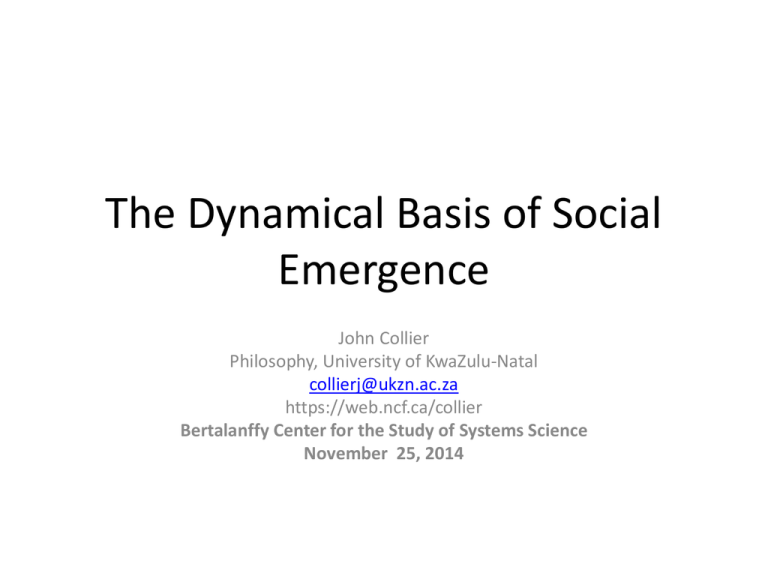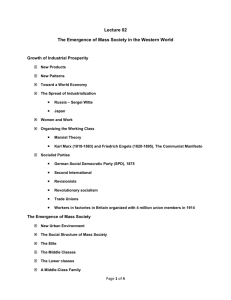The Dynamical Basis of Social Emergence
advertisement

The Dynamical Basis of Social Emergence John Collier Philosophy, University of KwaZulu-Natal collierj@ukzn.ac.za https://web.ncf.ca/collier Bertalanffy Center for the Study of Systems Science November 25, 2014 Outline • Three problem areas for social emergence • Some misconceptions about emergence • The problems in more depth and the nature of emergence • Summary on emergence • Summary on social emergence • Some topics for discussion The problems: 1. Weak and strong emergence • Emergence is recognized as coming in two forms: weak and strong (Collier, Bedau, Chalmers) • They have very distinct properties, and should not be confused. • Weak emergence is reducible and fully analyzable (all computational models so far, flocks, game of life, etc.) • Strong emergence is not reducible, and is not computable (so far). This is traditional emergence in 19th Century and 20th Century philosophy (J.S. Mill, C.D. Broad). The problems: 2. Qualitative characterization • Emergence is typically described in qualitative (or in logical) terms: novelty, irreducibility, whole greater than sum of parts, unpredictability, self-organized, selfinteracting, etc. • However, we interact with things through forces and flows, i.e., dynamically. We often ignore this in everyday life (naïve realism), but in science we need to pay attention to how we detect things in order to understand what we detect. • So we need a dynamical characterization of emergence to be able to test for it by interactions. The problems 3: Boundary condition inseparability from system laws is diagnostic of emergence • In classical mechanics and quantum mechanics system laws and boundary conditions are typically assumed to be independent of each other. This is always true if the system is a conservative system, typically called a Hamiltonian system. All QM systems are Hamiltonian systems. (Technically, Hamiltonian systems are a broader class.) None of these systems can show strong emergence. • They are also called holonomic, meaning their variables depend only on location and perhaps time, but not velocity. • Near Hamiltonian systems can be approximated with perturbation theory at one end of the scale, or step functions at the other end of the scale, but in the middle predictability fails, computability (even approximate) fails, self-organization is possible, novel properties appear, and , of course, the system is strongly self interacting, as system laws and boundary conditions are not separable. The problems 3 continued: Diagnosis • All known such systems are dissipative. • But we typically don’t have a detailed mathematical description of the dynamics of biological and psychological systems, let alone social systems, so how can we determined if this diagnostic dynamical condition occurs? • Typically, we fall back on qualitative properties, but this leaves us open to errors in judgement. • What is dissipated? Some mistaken ideas about emergence 1 There are some mistaken ideas of emergence that are relevant to the three problems for understanding and testing social emergence • Mystericism (separate substances, causal independence, and teleology) ̶ two critics once objected that my account of emergence makes it too simple, comprehensible, which they thought begged the question • Emergence is purely epistemological, possibly resulting from limitations on our minds. Only nominal. Eliminable in principle if we think differently. • Emergence is a property of our models of the world, not of the world itself. Suggests that with the right models, emergence would disappear. If only it were that easy! Some mistaken ideas about emergence 2 • • • Emergence results from complexity alone, (Bar-Yam 2011): “In conventional views the observer considers either the trees or the forest. Those who consider the trees consider the details to be essential and do not see the patterns that arise when considering trees in the context of the forest. Those who consider the forest do not see the details. When one can shift back and forth between seeing the trees and the forest one also sees which aspects of the trees are relevant to the description of the forest. Understanding this relationship in general is the study of emergence.” He goes on to give an example: “Consider a key. A description of a key's structure is not enough to show us that it can open a door. To know whether the key can open a door, we need descriptions of both the structure of the key and the structure of the lock. However, we can tell someone that the function of the key is to unlock the door without providing a detailed description of either.” Emergent computation is more than merely a simulation of emergence. Computation that terminates is by definition computable and hence reducible. As a corollary, numerical models of strongly emergent systems are necessarily not emergent themselves, and thus are misleading. Problem 1: Weak versus strong emergence • The distinction is useful to make between properties (or systems) that must be understood as a whole, including their large scale interactions but are nonetheless reducible (weak emergence) from those that are not reducible (strong emergence). The NECSI version of emergence is the weak sort. • The distinction has been made by (among others) myself and Scott Muller (1998), Mark Bedau (1997), David Chalmers (2006). Note that Chalmers’ usage is divergent and applies only to mental qualia. • In 1986 I introduced the notion of cohesion to cover dynamical unity in general. Cohesion is the property that makes a dynamical unity of parts of something. The cohesion in strong emergence is not reducible. • Cohesion applies to properties as well as systems (Every Thing Must Go). All systems are individuated by their cohesion. If the cohesion of the system is an emergent property (weak or strong, respectively), then the system itself is emergent (weak or strong, respectively). So property emergence is more fundamental than system emergence. Paul Humphreys and “fusion” • Many theorists use an obsolete reductionist ontology of particles and collisions, which we call (Every Thing Must Go) “microbangings” of myriad “little things”. This ontology is not compatible with current science. • Paul Humphreys pointed out that when parts act under each others’ influence many of the properties of the parts no longer exist, the system forming a “fusion” with properties of its own. For example, a planet orbiting the Sun has a dynamics that are the result of the interaction of the planet's properties and those of the Sun, forming a fused dynamics. These are the real dynamics of the system, not some construct out of the independent dynamics of the parts of the system and their relations. • Humphreys recognized that the fused dynamics are possibly reducible, but the whole is cohesive and has at least the property of weak emergence. • This idea helps to resist the tendency that there must be some still existing components with their own individual properties. The system is not the sum of its components because the components are fused. A nonreducible fusion will be strongly emergent. The historical ground of the emergence concept • Origin of the concept – vitalism debate versus naturalism and the unity of the sciences – G. H. Lewes in 1875: something that is incommensurate with its components and not reducible to their sum or their difference – J. S. Mill (A System of Logic, Bk.III, Ch.6, §1, 1843) does not use the word: “All organised bodies are composed of parts, similar to those composing inorganic nature, and which have even themselves existed in an inorganic state; but the phenomena of life, which result from the juxtaposition of those parts in a certain manner, bear no analogy to any of the effects which would be produced by the action of the component substances considered as mere physical agents. To whatever degree we might imagine our knowledge of the properties of the several ingredients of a living body to be extended and perfected, it is certain that no mere summing up of the separate actions of those elements will ever amount to the action of the living body itself.” – C. D. Broad (The Mind and Its Place in Nature, 1925): While Emergentists, too, are physical substance monists (“there is only fundamentally one kind of stuff”), they recognize “aggregates [of matter] of various orders” — a stratification of kinds of substances, with different kinds belonging to different orders, or levels. Each level is characterized by certain fundamental, irreducible properties that emerge from lowerlevel properties. A primary concern of Broad was an ontological deflation and ultimate unity of both the sciences and of the world. • Clearly these people were talking about strong emergence. Problem 2: Logical conditions for (strong) emergence 1. 2. 3. 4. Non-reducibility of emergent properties Non-predictability of emergent properties Holism Novelty of emergent properties Problems with this approach: Conditions 1-4 are hard to detect experimentally and difficult to distinguish from epiphenomenal properties. We need dynamical (interactive) conditions for emergence. • • Humphreys’ fusion is necessary but not sufficient, though dynamical). Robert Rosen (1991): profound criterion: analytic but not synthetic models – – – • Synthetic models are a sum of their parts and pairwise relations, or can be analyzed fully in terms of their inputs and outputs Analytic models need not have any corresponding synthetic models. If so, they cannot be reduced to their parts or input-output relations. However this is a logical condition of models, not systems themselves. Wimsatt (2007): non-aggregativity – closer to a dynamical view, but not much different from Lewes and Mill. Complex organization and emergence • • • (Collier and Hooker 1999) The basic idea of an organized system is that it is interconnected in complex ways, so that there are both local and nonlocal effects. Complex organization – involves neither summation nor top down control, but shows an interaction of bottom-up effects and top-down effects – Complexly organized systems cannot be decomposed Thus they show the characteristics of emergent systems Problem 3: Computational notions connected to dynamics • Non-reducibility: A property is nonreducible if it cannot be computed from additive (or subtractive) combinations of the dynamics of its parts. • Non-predictability: the trajectory of a system is predictable if and only if there is a region η constraining the initial conditions at t0 such that the equations of motion will ensure that the trajectory of the system will pass within some region ε at some time t1, where the region η is chosen to satisfy ε. For indeterministic systems, the values are determined to the extent determined by the probabilistic factors in the laws. Otherwise it is non-predictable. Failure implies chaotic regions and possible bifurcations. • Connecting to dynamics: All holonomic systems (constraints are expressible as functions as spatial coordinates and perhaps time, but not in general velocity) are reducible and predictable. All traditionally studied Hamiltonian systems (the subject of most physics) are holonomic. • So non-holonomicity is required for emergent systems with emergent properties. The state taken by such systems depends on the path taken. Separation of boundaries and system laws • Conrad and Matsuno (1990) – Differential equations provide the major means of describing the dynamics of physical systems in both quantum and classical mechanics. The indubitable success of this scheme suggests, on the surface, that in principle it could be extended to a universal program covering all of nature. The problem is that the essence of a differential equation description is a separation of itself from the boundary conditions, which are regarded as arbitrary. • We cannot do this, in general, for non-holonomic systems. • The problem is not that we cannot separate laws and boundary conditions, but rather that the system itself does not allow this sort of solution. We can still understand the system in terms of laws and boundary conditions, but this does not allow us to give full solutions for its behavior. Necessary conditions for emergence • Non-Holonomic systems – Basically, energy (or some central system property) is not conserved, e.g., dissipative systems. – Boundary conditions and system laws cannot be separated in principle in the system dynamics. In particular, the system can (under some conditions) do work on its boundary conditions, constructing new properties. – Near holonomic we can approximate at one end by step functions, and at the other end by perturbation theory. – Radically non-holonomic systems, however, are a problem. I call these radically non-Hamiltonian if the rate of energy dissipation is of the same order as some system property. Likely strongly emergent systems • Mercury and the Sun (3:2 rotation to orbit period) • Bénard Cells • A wheel (region of stability, but outside that unpredictability emerges). • Cell differentiation (not fully under DNA control) • Ant behaviour of some sorts • Non-selective sympatric speciation • Living systems (the original prototype for strong emergence) • The mind and/or its contents (?), Social properties (?) Problem 3: applying the dynamical conditions to general emergent systems • My characterization of emergent systems uses concepts from physics that are clear in that realm. • However, as some of the examples show, emergent systems are often not easy (or perhaps possible) to be characterized in terms of physical equations. • We need other ways to characterize emergence dynamically for systems that are not obviously physical, or physical chemical. Some possible approaches 1. 2. 3. 4. We can look at most systems from the perspective of forces and flows in networks. This is a dynamical representation. If the laws governing the forces and flows interact then we have a candidate for emergence. In particular, there are certain types of system equations that are mathematically impossible to solve. If system networks of causal processes show closure, such that inputs depend on outputs, we have a good candidate for an emergent system or subsystem (Rosen – “closure to efficient causation”). Many higher level systems (biological, mental) can be characterized in terms of information. If information is dissipated in the system at a similar rate to the rates of one of the properties on which it depends, then the property is likely to be emergent. Is there a similar social property? Is it information? Might there be others? These are all open questions to the best of my knowledge. Ordinary Partial Differential Differential Trivial Easy Difficult Easy Difficult Intractable Many Parameters Intractable Intractable Impossible One Parameter Very Difficult Very Difficult Impossible Very Difficult Impossible Impossible Equation: Algebraic One Parameter Linear Several Equations Parameters Nonlinear Several Equations Parameters Summary on emergence in general • Weak and strong emergence often confused. This requires clear criteria for reducibility that can be tested, since the properties of strongly and weakly emergent systems are significantly different. • Only dynamical criteria can be tested through interactions. Logical and qualitative criteria are difficult to test directly in a reliable way. • Emergence requires dissipation. Energy is obvious in physical systems, but information dissipation might also work. Other properties might also be appropriate (word usage, meaning dissipation, corporate dissipation). Summary on social emergence • Information dissipation might apply, but how is not obvious. • It is especially difficult to distinguish strong and weak emergence, so care is advised. • Other candidates for the dynamic basis of social emergence are not obvious. They may be multiple and apply in different circumstances. Some topics for discussion • Cultural emergence – New and integrated trends – Through interactions of pre-existing cultures • Emergence of a public sphere that is quasiindependent and hence (interactively) autonomous from government and private spheres • Interaction with environment and other social systems while maintaining a degree of autonomy.





